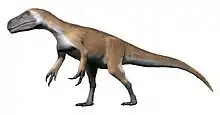Sierra Barrosa Formation
The Sierra Barrosa Formation is a geologic formation of the Neuquén Basin in the northern Patagonian provinces of Mendoza and Neuquén. The formation dates to the Late Cretaceous, middle to late Coniacian, and belongs to the Río Neuquén Subgroup of the Neuquén Group. The formation overlies the Los Bastos Formation and is overlain by the Plottier Formation. As the underlying Los Bastos Formation, the Sierra Barrosa Formation comprises mudstones and sandstones deposited in a fluvial environment.
| Sierra Barrosa Formation | |
|---|---|
| Stratigraphic range: Mid-late Coniacian ~ | |
| Type | Geological formation |
| Unit of | Neuquén Group Río Neuquén Subgroup |
| Underlies | Plottier Formation |
| Overlies | Los Bastos Formation |
| Thickness | Up to 62 m (203 ft) |
| Lithology | |
| Primary | Mudstone |
| Other | Sandstone |
| Location | |
| Coordinates | 38°52′10″S 68°51′20″W |
| Approximate paleocoordinates | 42.8°S 48.4°W |
| Region | Mendoza & Neuquén Provinces |
| Country | |
| Extent | Neuquén Basin |
| Type section | |
| Named for | Sierra Barrosa |
| Named by | 2010 |
| Year defined | Garrido |
 Sierra Barrosa Formation (Argentina) | |
Description
The formation was named by Garrido in 2010 as sandy unit conformably and transitionally overlying the Los Bastos Formation, which in turns overlies the Portezuelo Formation within which both units were formerly included. The formation in the same manner underlies the Plottier Formation, all belonging to the Río Neuquén Subgroup of the Neuquén Group in the Neuquén Basin. The unit now known as Sierra Barrosa Formation was included in the original definition by Herrero Ducloux (1938, 1939) as "Portezuelo Superior", as part of the "Portezuelo Beds" he described.[1]
The type locality of the formation is located at the southern edge of the eponymous Sierra Barrosa, to the east of Cerro Challacó. The formation at its type section reaches a thickness of 62 metres (203 ft). The formation comprises fine-to-medium grained sandstones intercalated by thin levels of mudstones. The formation has similar lithological characteristics as the Portezuelo Formation and was deposited in a fluvial environment characterized by highly sinuous channels. Based on the stratigraphic relations with the overlying and underlying units, the age has been estimated to be middle to late Coniacian.[1]
Fossil content
Crocodylomorphs
| Crocodylomorphs reported from the Sierra Barrosa Formation | |||||
|---|---|---|---|---|---|
| Genus | Species | Presence | Material | Notes | Images |
| Comahuesuchus | C. bonapartei | Futalongko Quarry.[2] | Partial right mandible (MUCPv 597).[2] | A notosuchian, locality may being to the Portezuelo Formation. | |
Ornithischians
| Ornithischians reported from the Sierra Barrosa Formation | |||||
|---|---|---|---|---|---|
| Genus | Species | Presence | Material | Notes | Images |
| Macrogryphosaurus | M. gondwanicus | Mari Menuco Lake.[3] | Near-complete skeleton.[3] | An elasmarian. |  |
Sauropods
| Sauropods reported from the Sierra Barrosa Formation | |||||
|---|---|---|---|---|---|
| Genus | Species | Presence | Material | Notes | Images |
| Kaijutitan | K. maui | Cañadón Mistringa.[4] | Partial skeleton.[4] | A titanosaur. | |
| Mendozasaurus | M. neguyelap | Arroyo Seco.[5][6] | Partial skeleton and disarticulated bones.[5][6] | A titanosaur. | |
Theropods
| Theropods reported from the Sierra Barrosa Formation | |||||
|---|---|---|---|---|---|
| Genus | Species | Presence | Material | Notes | Images |
| Allosauroidea indet. | Indeterminate | Cañadón Mistringa.[7] | Proximal end of left tibia (MAU-PV-CM-653).[7] | An allosauroid. | |
| Maniraptora indet. | Indeterminate | Arroyo Seco.[6] | A maniraptoran. | ||
| Murusraptor | M. barrosaensis | Sierra Barrosa.[8] | Partial skeleton (MCF-PVPH-411).[8] | A megaraptorid. |  |
References
- Alberto, Garrido (May 2011). "El Grupo Neuquén (Cretácico Tardío) en la Cuenca Neuquina". 18º Congreso Geológico Argentino (in Spanish): 231–244.
- Kellner, Alexander W. A.; Figueiredo, Rodrigo G.; Calvo, Jorge O. (2023). "A new species of Comahuesuchus Bonaparte, 1991 (Crocodyliformes: Notosuchia) from the Upper Cretaceous of Neuquén, Lake Barreales, Patagonia, Argentina". Anais da Academia Brasileira de Ciencias. 95 (suppl 1): e20230179. doi:10.1590/0001-3765202320230179. ISSN 1678-2690. PMID 37585972. S2CID 260910113.
- Rozadilla, Sebastián; Cruzado-Caballero, Penélope; Calvo, Jorge O. (April 2020). "Osteology of Ornithopod Macrogryphosaurus gondwanicus (Dinosauria, Ornithischia) from the Upper Cretaceous of Patagonia, Argentina". Cretaceous Research. 108: 104311. Bibcode:2020CrRes.10804311R. doi:10.1016/j.cretres.2019.104311. S2CID 213679041.
- Filippi, Leonardo S.; Salgado, Leonardo; Garrido, Alberto C. (2019-08-01). "A new giant basal titanosaur sauropod in the Upper Cretaceous (Coniacian) of the Neuquén Basin, Argentina". Cretaceous Research. 100: 61–81. Bibcode:2019CrRes.100...61F. doi:10.1016/j.cretres.2019.03.008. ISSN 0195-6671. S2CID 134843807.
- Bernardo J. Gonzalez, Riga; Mannion, Philip D.; Poropat, Stephen F.; David, Leonardo D. Ortiz (September 2018). "Osteology of the Late Cretaceous Argentinean sauropod dinosaur Mendozasaurus neguyelap: implications for basal titanosaur relationships". Zoological Journal of the Linnean Society. 184 (1): 136–181. doi:10.1093/zoolinnean/zlx103.
- González Riga, B. J. (2003). "A new titanosaur (Dinosauria, Sauropoda) from the Upper Cretaceous of Mendoza Province, Argentina". Ameghiniana. 40: 155–172.
- Baiano, Mattia; Filippi, Leonardo (2022). "Allosauroid (Theropoda, Tetanurae) remains from the Sierra Barrosa Formation (Middle Coniacian, Upper Cretaceous), Patagonia, Argentina". Publicación Electrónica de la Asociación Paleontológica Argentina. 22 (1): 1–10. doi:10.5710/PEAPA.25.10.2021.396. S2CID 246334899.
- Coria, Rodolfo A.; Currie, Philip J. (2016-07-20). "A New Megaraptoran Dinosaur (Dinosauria, Theropoda, Megaraptoridae) from the Late Cretaceous of Patagonia". PLOS ONE. 11 (7): e0157973. Bibcode:2016PLoSO..1157973C. doi:10.1371/journal.pone.0157973. ISSN 1932-6203. PMC 4954680. PMID 27439002.